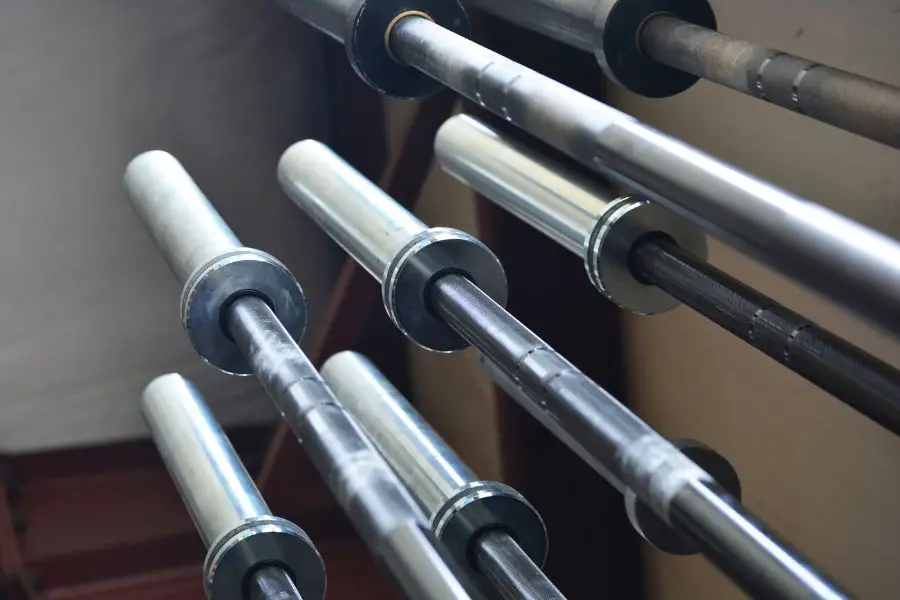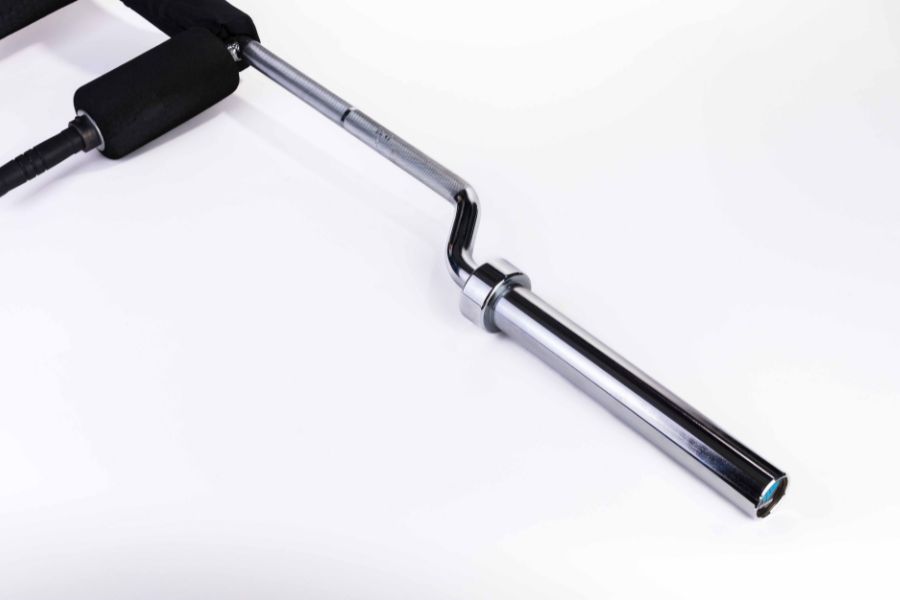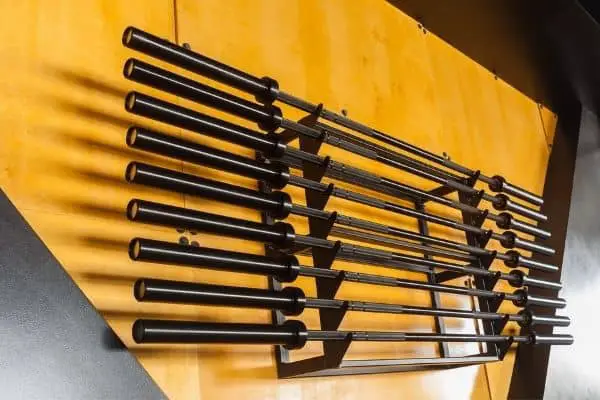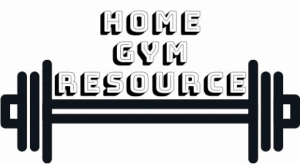Choosing the right barbell is key to getting a great home or garage gym experience. Picking the wrong one might leave you with something that doesn’t fit you or your gym very well. How do you choose the right barbell?
By choosing a straight Olympic barbell you’re on the right track for choosing a good bar. Then just pick a length, diameter, and coating that fits you and your needs. There are some minor features that could impact your decision but those mentioned are the most important.
In the rest of this article, we’ll go into all the details of picking a barbell and which diameter, lengths, etc. work best for your situation.
Contents
Factors to Consider When Choosing a Barbell
There are quite a few things to look at when choosing a barbell. I’ll try to break it down as easily as possible but sometimes it might get a little technical.
I’m going to assume you need a good, general-purpose, barbell for your garage gym and not something specialized.
Here is a quick summary of all the points below, if you need more information, keep reading.
| Factor | Best For Most People | Alternative/Note |
|---|---|---|
| Type | Always choose a bar with Olympic (50mm diameter) sleeves. | |
| Shape | Straight | |
| Lenght | 6’6-7’2 barbells fit on all racks and have plenty of load capacity. | Some 6′ barbells fit on a squat rack and save space. |
| Weight | 20 kg (44 lbs) Is best for most people. | 15 kg (33 lbs) for when 20 kg is too heavy to start with. |
| Shaft Diameter | +-28 mm for people with large hands. | 25 mm for people with small hands. |
| Corrosion Protection | Stainless steel barbells are the best but expensive. | Cerakote, Chrome or E-Coat coatings are good yet cheaper alternatives. |
| Load Capacity | At least 165k+ but preferably around 190k+ PSI tensile strength. | |
| Knurling | Mild knurling for general fitness, normal loads. | Agressive knurling for very heavy lifts where grip is important. (Deadlifts). |
| Budget | For $200-$300 you can find a great barbell for a garage gym. A bit more for a stainless steel one. | Avoid bars under +-$150. |
Want to find which barbells are best for a garage gym? Click here to find the top 3.
1. Standard vs. Olympic
Determine whether you need a standard barbell (1-inch diameter sleeves) or an Olympic barbell (2-inch diameter sleeves) based on the type of weight plates you plan to use. Olympic barbells are more versatile and commonly found in gyms.
Always pick an Olympic style barbell with 50mm sleeves as your all-round home or garage gym bar.

If you don’t already have 1″ weight plates, go for the Olympic-style 2″ barbell and plates. You’ll get a better barbell and much more choice. The path to upgrading your barbell or adding plate-loaded equipment later on is also much easier.
Olympic barbells also have spinning sleeves which improve your lifting form and reduce the torque on your wrists, elbows, and shoulders which means a lower injury risk.
2. Barbell Types and Variations
There are a lot of different barbells that have special shapes and functions. And that’s exactly what they are; special. They are for specific training styles or even for specific exercises. As a first, all-round barbell, you just want a straight bar.
All the other variations are not practical as general-purpose barbells.

3. Barbell Length
One thing you have to pick by yourself is the bar length. Standard Olympic barbells are about 79″ or 86″ long. There are other lengths available though.
You can read here about the standard lengths of barbells and where they come from.
The shortest bar that works as an all-round barbell in a home gym is 6′. And you have to be picky since not all 6′ bars will work. Here is an article that explains why that is and which 6′ bars are good.
For larger home/garage gyms, a 6’6 – 7’2 barbell is best since they fit on all racks and have plenty of load capacity. For small spaces, some 6′ bars can work if they have the right shaft length to fit on a squat rack.
The benefit of a shorter bar is that it takes up less space and is easier to move around. The drawback of shorter bars is that you have shorter sleeves which means less load capacity. For most people, this doesn’t matter since you can still easily load 500 lbs. on there.
Some 6′ bars have shorter shafts which means they don’t fit on a rack. That’s what you have to be careful of with shorter bars.
There are shorter, 4′ and 5′ barbells available but those aren’t any good as general-purpose barbells since they don’t fit on squat/power racks. 6′ barbells can fit if you pick the right one, longer than 6′ will always fit on a rack.
Also, keep in mind that shorter barbells are often lighter. They often weigh 15 kg instead of 20 kg. Not that big a deal but something to remember.
4. Barbell Weight
The weight of the barbell itself is crucial, especially if you’re new to lifting. Olympic barbells typically weigh 15 or 20 kg (33 or 44 pounds).
Don’t only think about your strongest lifts but especially about your weakest. What’s the warm-up weight on your weakest lifts? Is 20 kg too much? Then use a 15 kg bar.
Most men will be fine with a 20 kg bar while most women have a better time starting with a 15 kg barbell. You can always load on more weight plates so going heavier isn’t the problem, the starting weight is.
5. Barbell Shaft Diameter
Diameter is an important one. Most barbells have a 28 mm shaft while some have 25 mm bars. There are some exceptions to those but they’re relatively rare. Here is an article that goes in-depth on barbell shaft diameter.
The diameter of the barbell’s shaft influences grip comfort and performance. It’s personal though. Some people are better suited for 25 mm bars and others for 28 mm shafts.
Hand size is the most important deciding factor. Small hands (average female hand) are better suited to 25 mm bars. The average man’s hands work better around a 28 mm shaft.

6. Corrosion Resistance
The material of the bar itself is usually alloy steel. Without any further treatment, barbells are susceptible to corrosion. This makes picking one with a good anti-corrosion coating important. A good coating will reduce maintenance needs and increase longevity.
Stainless steel bars are rust proof and very durable but quite expensive. Good, cheaper anti-corrosion coatings for barbells are; Cerakote, Chrome, or E-coat.
Some of the best are; Cerakote, chrome, and E-coat. Some less effective/durable (but cheaper) ones include; zinc and black oxide.
There are barbells that are completely made out of stainless steel. These have great corrosion resistance which doesn’t wear off but they’re pricey. If you can get a deal on a stainless steel barbell, it’s a great choice.
You can find a full guide to all popular barbell anti-corrosion coatings in this article.

7. Load Capacity
The load capacity can mean two things. 1. How much weight physically fits on the sleeves? 2. How much weight the bar can handle before bending?
If you’re an average lifter and have chosen an Olympic bar, you won’t have to worry about either of those things.
The physical maximum load capacity depends on the loadable sleeve length. sleeve lengths differ from about 9″ to 16.5″. With standard steel plates, you can still load 360 lbs. on the shortest sleeve. Most standard sleeves are around 16″ long which can hold 810 lbs. and a collar. So you can see this is likely not an issue for you.
The max load before bending is a bit different. The spec to look at here is the PSI rating of the barbell. Usually measured in thousands of PSI (Pounds per Square Inch). This is the pressure rating the barbell can handle. We could go into a whole technical discussion about tensile strength and yield strength here but let’s just stick to the guidelines everyone can use.
Look for a barbell with a PSI rating of at least 165.000 and preferably 190.000. That will ensure a bar that’s strong enough to live a long life in a home, garage gym or even CrossFit gym.
Just as an indication, Rogue makes most of their barbells with a 190k+ rating and the bars for really heavy loads have a 215k+ rating.
8. Build Quality
This is a hard one to quantify but build quality is important. The best way to get a well-built bar, buy one with good reviews and/or from a reputable brand.
Lower-quality bars might look nice when they’re new but they wear out faster, don’t feel as nice in your hands, and the sleeves don’t spin as smoothly.
Price gives you a pretty good idea of quality but it’s not a perfect indicator. For most home and garage gyms, you don’t need super high-end barbells. For most people who just want to lift weights and get to an intermediate level, a mid-range barbell is perfectly fine.
9. Knurling and Grip
Finally, there is a small thing to look for and that’s knurling. The knurling is the cross-hatched pattern in the shaft of a barbell. This can be higher and more aggressive or lower and less aggressive.
1.2 and 1.5 mm high knurling is common. The latter is the more aggressive one.
Aggressive knurling offers a stronger grip but can be uncomfortable during high-repetition exercises. It rips up your hands on heavy, high-rep lifts. Mild knurling provides a more comfortable grip for longer workouts.
Mild knurling is best for most general fitness and weightlifting. But if you lift heavy, more aggressive knurling is necessary.
10. Budget
As always, you need to consider the price of an item before buying it. Buying the best barbell in the world isn’t going to help you if you can’t afford weight plates anymore.
For about $300 you can get a great mid-range barbell for a home or garage gym. Even for $200, you can find a very decent one that lasts a long time. For a rust-proof stainless steel barbell, you can expect to pay $300-500.
Try to avoid barbells under +-$150.
Read more in this barbell price guide.
Advanced Barbell Features
Finally, there are a few small things that don’t matter that much but might nudge you one way or the other which picking a barbell.
1. Whip and Flexibility
If you know what whip is, you probably don’t need this guide but for the people that are interested, here we go.
Whip is the degree to which the bar flexes under load. So we’re not talking about permanent bending. More whip can be beneficial for deadlifting but it’s detrimental to squats and benches.
For general-purpose barbells, you want something in the middle. not too stiff but also no wet noodle. Most general barbells are within a good range and you don’t have to worry about it.
If you’re an advanced lifter and want a separate bar for squatting, deadlifting, etc. you should look for a special bar for that purpose. To turn that around, don’t buy a specialty bar as a general barbell.
2. Sleeve Rotation
If you pick an Olympic barbell (like you should) the sleeves are always going to rotate. And that’s a good thing.
How freely and smoothly the sleeves spin depends. In short, you need very smooth and free spinning sleeves for Olympic lifts like the clean and jerk and snatch. That means needle-bearing sleeves.
For all other types of lifting, less free-spinning sleeves are perfectly fine. That means ball bearings or bushings are good. They’re actually a bit more durable as well.
3. Center Knurling
Some barbells have a piece of knurling in the middle of the bar while others don’t. This is a result of the different standards for men’s and women’s Olympic barbells.
In the real world, this piece of knurling doesn’t really matter except for heavy squats. While squatting heavy, this knurling provides a little bit of extra grip on your back to keep the bar in place. If you intend to squat very heavy, getting a bar with center knurling is a good idea.
4. Sleeve Coatings and Maintenance
The coating on the sleeves is a minor thing since most of them are the same. Most sleeves are chromed since it works well and is pretty cheap. Chrome sleeves are absolutely fine for pretty much all barbells.
Some sleeves are ceramic coated. This is usually done to make the bar look cool by making it another color than silver. If you want that, go ahead, just be aware that ceramic coating on sleeves tends to scratch pretty easily.
5. Warranty and Customer Reviews
When buying anything, you should check the warranty conditions and customer reviews. A high-end barbell might have a lifetime warranty whereas others just have a year. It’s up to you to decide if that warranty is worth the extra money to you.
And of course, reading customer reviews on Amazon and Reddit for example helps a lot to figure out which bars are good and which aren’t.
What Kind Of Barbell Should You Avoid?
Knowing what to select for is one thing. Knowing what to kind of barbells to avoid is just as valuable. Here are some types of barbells you might want to stay away from:
Appendix: Glossary of Barbell Terminology
The terminology can be confusing for beginners and people not familiar with the jargon. Here’s a glossary of common terms associated with barbells to help you make informed decisions when choosing the right one.:
I hope that helps to decipher the listings and descriptions of different barbells so you can make the right choice!

